Texas is home to hundreds of spider species. We aren’t going to list all of them here, so we have listed the top 60 most common spiders you are likely to encounter, ranging from the most popular to the least popular.
Continue reading to find out more about the 60 common spiders in Texas.
Table of Contents
1. Yellow Garden Spider
Scientific name: Argiope aurantia
Common name: yellow garden spider, black and yellow garden spider, golden garden spider, writing spider, zigzag spider, zipper spider, black and yellow argiope, corn spider, Steeler spider, McKinley spider.
The yellow garden spider is a black and yellow spider, first described in 1833.
Males grow to 0.35 inches (9mm) with females growing to 1.10 inches (28mm).

They often build webs in open sunny fields where they can stay protected. They are also often encountered on eaves of homes and outbuildings, along with tall vegetation where they can secure their web.
They are not dangerous to humans, but they will bite if you disturb or harass them.
2. Bold Jumping Spider

Scientific name: Phidippus audax
Common name: daring jumping spider, bold jumping spider.
The bold jumping spider is a small jumping spider that is able to jump four times it’s body length, which helps them ambush prey and escape predators.
Due to the fact that they are not easily caught, the chances of being bitten is very slim. Their venom is not lethal and gives the feeling of a sting for a short period.
These black spiders have a white line that runs across the top part of the belly. They also have two bright dots close to the back of the belly. Their legs have white hairy patches.
They live in just about any habitat from cars to homes.
They are wandering hunters and do not spin webs to capture their prey.
3. Spinybacked Orbweaver

Scientific name: Gasteracantha cancriformis
Common name: Spinybacked orbweaver.
The spinybacked orbweaver was first described in 1833.
Females are brightly colored with six spines on their abdomens. Males are considerably smaller than the female and they lack the spines and bright colors.
They will bite if they are threatened, but they are completely harmless to humans.
4. Rabid Wolf Spider

Scientific name: Rabidosa rabida.
Common name: rabid wolf spider.
Rapid wolf spiders are fast-moving and erratic in their motions, which is how they got the name.
They do not carry Rabies, so you do not have to worry, but they are aggressive and will challenge animals and humans.
They do prefer to run away rather than to bite. Their bites are painful but are not considered medically significant. Bites heal on their own and do not require any medical treatment, a cold compress can help reduce pain, swelling, and redness.
They are light brown in color with two dark brown lines on the sides of the head and one dark brown line down the center of their abdomen with two thinner lines on the sides of the body.
5. Green Lynx Spider

Scientific name: Peucetia viridans.
Common name: green lynx spider.
Female green lynx spiders are considerably larger than the males, growing up to 0.87 inches (22mm), while males grow to 0.47 inches (12mm) n length.
They have a red patch between the eyes and some red dots on the body. The abdomen has six chevron-like markings with the center pointing forward. They have green to yellow legs with long black spines.
They change their color from green to pale yellow with red streaks later in the season. Gravid females are known to change color to blend into the background. The color change can take up to sixteen days.
They seldom bite humans, but if they do, they pack a painful bite, though it is not deadly, but may cause swelling which can be managed with a cold compress.
6. Texas Brown Tarantula
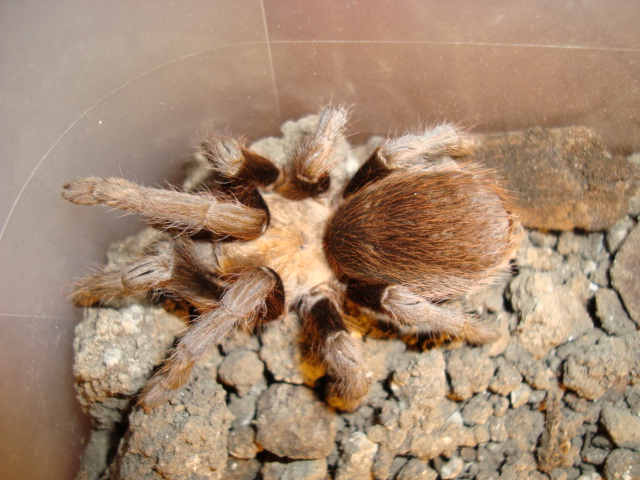
Scientific name: Aphonopelma hentzi.
Common name: Texas brown tarantula, Oklahoma brown tarantula, Missouri tarantula.
The Texas brown tarantula is a docile spider that is often seen wandering around in nature.
Their bodies are lighter brown than their legs. Legs have gray to white hues on them, the main body is covered in orange hairs that are rubbed off should the spider feel threatened. Their hairs can get embedded in your skin, causing irritation.
They are not aggressive, but they will defend themselves, usually running for cover as a first resort.
They are often observed in open fields, farmlands, under-leaf litter, and woodpiles. It’s not uncommon for them to find their ways indoors by accident.
Further Reading:
7. Twin-flagged Jumping Spider

Scientific name: Anasaitis canosa.
Common name: twin-flagged jumping spider.
The twin-flagged jumping spider has what looks like a fifty pair of legs on its face. These are used to help the spider sense its environment.
They are black with two to four white marks on the head. There is a white dash in the center of the abdomen and a large white ring encircling the dash with some light chevrons. Legs are light in color with dark bands.
They pounce on their prey and do not rely on webs to capture insects.
They are often seen moving around on the forest floor, sometimes wandering into homes hunting for food.
They are not dangerous and will leap away in order to escape.
They are small but very fast.
8. Spotted Orbweaver

Scientific name: Neoscona crucifera
Common name: Hentz orbweaver, spotted orbweaver, barn spider.
The spotted orbweaver spins a two-meter diameter web, which they hide in during the day.
These spiders can vary in color with some being red to orange, others being tan and some yellow to brown. Some have a visible pattern on their abdomen, while others don’t.
They do all have bristles on their head, legs, abdomen, and thorax.
They are usually found in woodlands, fields, gardens, backyards, and parks where they are mostly active during May and August.
9. Striped Lynx Spider

Scientific name: Oxyopes salticus
Common name: striped lynx spider.
The striped lynx spider can range from brown to orange or cream.
Females have stripes on both sides of the abdomen and grow up to 6mm, while males are smaller growing to 5mm.
They are harmless to humans and are more likely to try and run and hide than to bite. A bite can be painful but will heal on its own without medical intervention.
10. Tan Jumping Spider

Scientific name: Platycryptus undatus
Common name: tan jumping spider.
The tan jumping spider uses its fantastic jumping abilities to ambush their prey. They leap towards prey with a strand of silk that keeps the insect in tow. This helps reduce the risk of the prey escaping.
They seem very curious of humans and will quite happily jump from one finger to another.
They are not inclined to bite, but they can, especially if you handle them roughly.
11. Triangulate Cobweb Spider

Scientific name: Steatoda triangulosa
Common name: triangulate cobweb spider, triangulate bud spider.
The triangulate cobweb spider has a triangular pattern on their abdomen, making them easy to identify.
They are known to be common in homes, hiding in dark corners of sheds and rooms, attics, and basements.
They do not have good eyesight and rely on vibrations from their webs to help them find their prey.
They are not aggressive or venomous to humans. It spends its day rebuilding its web.
12. Golden Silk Spider

Scientific name: Trichonephila clavipes
Common name: golden silk orb-weaver, golden silk spider, banana spider.
Golden silk spiders are a type of orb-weaver with males being significantly smaller and less colorful than the female.
Females are some of the largest non-tarantula spiders in North America and can grow up to 4cm in length.
The females also have distinct colors making them easy to identify with a silver to white cephalothorax and an orange to brown elongated abdomen with two rows of white to yellow dots. Legs are dark yellow with brown branding.
Males are around one third of the size of the female and are slender in build. They are dark brown in body and legs with a black band on the legs.
This is not an aggressive species and only bite if roughly handled, their venom is harmless and does not require medical treatment, though it can cause localized pain and swelling.
13. Pantropical Jumping Spider

Scientific name: Plexippus paykulli
Common name: pantropical jumping spider.
The pantropical jumping spider has a large carapace and is covered in short gray hairs with some red accents in the males.
Females grow larger than the males to 0.47 niches (12mm) with males growing to 0.35 inches (11m) in length.
You can tell the male and female apart. Males have black abdomens and carapace with a large central white stripe and a broad white stripe on either side of two white spots near the back end of the abdomen. Females are brown to gray in color with it being darker around the eyes.
They have a wide tan stripe that runs onto the abdomen, which separates into two chevrons. They also have two white spots on the back end of the abdomen.
14. Southern Black Widow

Scientific name: Latrodectus mactans
Common name: southern black widow, simply black widow, shoe-button spider.
Black widow spiders are famous for their venom, but what you may not know is only the females are venomous.
Males don’t only lack venom, but they seldom bite. Females have powerful poison that is developed with age.
Males and females have a hairless and shiny body, usually completely black with a red hourglass on the back end of the abdomen.
Males tend to change patterns and colors as they age, but they are always around half the size of females.
Females eat the male after mating, which is why they have the name “widow”.
They are not aggressive and will not make an effort to bite humans. But when a female is protecting her eggs, she is more likely to attack and bite than run away.
A bite from a female black widow requires immediate medical attention. Not everyone feels the bite, but the pain will start at the bite area, spreading to the stomach and back with serious cramping for up to twelve hours.
Other symptoms include restlessness, fever, headaches, sweating, nausea, and tremors.
While fatalities from a black widow bite are very rare, immediate medical treatment can help reduce the symptoms.
15. Orchard Orbweaver

Scientific name: Leucauge venusta
Common name: orchard orbweaver.
Orchard orbweavers are long-jawed orb-weaver spiders that spin horizontal orientated webs, where the spider can hang down in the center.
This leaf green spider can vary from dark green to orange with a yellow and black spotted thorax and neon orange, red or yellow dots near the abdomen, which can vary in size, depending on the individual. In some it these dots are absent.
16. Mabel Orchard Orbweaver

Scientific name: Leucauge argyrobapta
Common name: Mabel’s orchard orb weaver.
The Mabel orchard orbweaver is a long-jawed orb-weaver with an oval body and red to orange triangular markings on its belly, which sets it apart from the other orb-weavers.
Males are smaller than the female growing to 4mm in body length, while females can grow up to 7.5mm in body length.
They will try and escape if approached, usually running to the edge of their orb-shaped web.
17. Silver Garden Orbweaver

Scientific name: Argiope argentata
Common name: silver argiope, silver garden orbweaver.
The silver garden orbweaver is a beautiful silver color which develops as it ages.
They can grow large with long silver and black legs with white bands. They have an orange or yellow abdomen with black stripes.
They make a zigzag patterned web, where the spider sits head down in the center.
They are often seen in parks, gardens, and open areas with an abundance of plants.
18. Common Hentz Jumping Spider

Scientific name: Hentzia palmarum
Common name: common hentz jumper.
The Hentz jumping spider is a small spider with a big jump.
They don’t rely on webs to capture prey but prefer an ambush technique by pouncing on them.
They are able to jump considerable distances, which is their main mode of attack, as they release a strand of silk to keep their prey in tow and reduce the risk of it escaping. Their large distance jump and their speed is what helps them escape threats.
Their first pair of legs are longer than the others. They are also red, where the others are yellow.
Their body is brown to red with white or dark bands.
These jumping spiders are usually observed on the ground among leaf litter, though they can make their way indoors hunting for prey.
19. Western Spotted Orbweaver

Scientific name: Neoscona oaxacensis
Common name: western spotted orbweaver, zig-zag spider.
The Western spotted orbweaver also spins a circular web in open areas, the spider then sits in upside down the center of the web where they wait for prey to get entangled.
They have a bulb-shaped abdomen in brown with yellow specks on the sides, the legs can be yellow or red with black bands near the base. There is a brown line that cuts through yellow triangles and dots on the abdomen.
They are usually observed in parks, gardens, and open fields during the fall when the females are laying their eggs.
20. Giant Lichen Orbweaver

Scientific name: Araneus bicentenarius
Common name: Giant lichen orbweaver.
This orbweaver species is found in the eastern part of the United States and in Canada.
They spin large webs which can reach up to eight feet in diameter.
Unlike the other orb-weavers that hang upside down waiting for prey, this species spends its time on the edge of its web.
Their bites are not considered dangerous to humans and bites are very rare, due to this spider being nocturnal. If accidentally bitten, the bite is compared to a bee sting.
21. American Nursery Web Spider

Scientific name: Pisaurina mira
Common name: American nursery web spiders.
Nursery web spiders are excellent mothers, which is why they go their name.
Females gently carry their sac with their fangs as they build a web, making it difficult to reach and less visible, often inside a leaf. She surrounds the sac with webbing and guards it until the eggs are hatched.
They are ambush predators with males looking slightly different from the females.
Females can be seen carrying white sacs among leaf litter with light brown to tan bodies with a dark brown streak down the middle of the abdomen and head.
Males’ streaks are lighter in color.
22. Gray Wall Jumping Spider

Scientific name: Menemerus bivittatus
Common name: Gray wall jumping spider.
The gray wall jumping spider is a flat spider covered in gray to white hairs with tufts of brown near the eyes.
They grow to 9mm in length with males being slightly smaller.
Males have a black dorsal stripe and a brown to white stripe on both sides of the abdomen.
Females are lighter in color, more brown with a larger abdomen and carapace. There are two black bands on her carapace and a broad black strip with white on the sides of the abdomen which join at the back.
They both have banded legs, though the females are lighter in color.
23. Banded Garden Spider

Scientific name: Argiope trifasciata
Common name: banded garden spider, banded orb weaving spider.
The band garden spider is an orb spider that spins orb-shaped webs in garden bed plants, sitting in the center facing upside down waiting for prey to get entangled.
The colors vary from one spider to the next, some are red-brown with white bands and others are black with white and yellow bands. Their color darkens with age.
They have a wide and round abdomen, furry carapace with silver hairs, and leg coloring the same as the head and abdomen.
They spin their webs low to the ground in tall grass, in shrubs, and gardens.
24. Tropical Orbweaver

Scientific name: Eriophora ravilla
Common name: tropical orb weaver.
Female tropical orbweavers can grow up to 24mm in length and can range from white to almost pure black. Some females are red-brown on their legs and cephalothorax.
The lower part of the abdomen is brown or gray with a triangular black mark pointing to the back, which is surrounded by gray.
Males are smaller, growing to 13mm in length, and similar to the female in color with a smaller abdomen, that is dark gray.
They have banding on their legs.
25. South American Toothed Hacklemesh Weaver

Scientific name: Metaltella simoni
Common name: South American Toothed Hacklemesh Weaver.
This brown spider’s females grow slightly larger than the male. Females grow up to 9mm, while the male grows to around 8.5mm.
Their brown bodies have some dark parts on the legs and the front of the carapace. The abdomen tends to be a mottled gray and black or gray with pale chevrons near the back.
Males have an orange to yellow patch on the back of the carapace that darkens to brown at the front.
26. Texas Tan Tarantula

Scientific name: Aphonopelma anax
Common name: Texas tan tarantula.
The Texas tan tarantula is the largest tarantula in the United States, growing to a leg span of five inches with some females recorded to reach a six-inch leg span.
They are slow growers and can live for many years before reaching maturity.
They are mostly tan and dark brown in color with urticating hairs, that it brushes off in the direction of predators or threats, these hairs can cause irritation if they make contact with your skin.
They are not aggressive and will only brush off their hairs if they feel threatened.
27. Six-spotted Fishing Spider
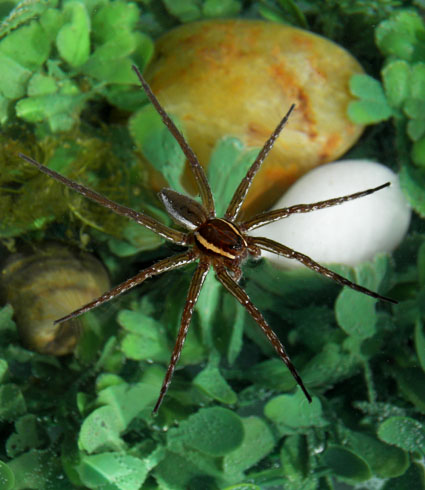
Scientific name: Dolomedes triton
Common name: six-spotted fishing spider, dock spider.
The six-spotted fishing spider is a large spider with eight eyes offering excellent vision.
The body is brown to gray with a white to pale cream stripe down either side of the cephalothorax. Their abdomens have light spots and lines.
Females are larger than males growing to around 2.4 inches (60mm) including their legs.
They are not considered medically significant and are often seen hurrying away as you approach rather than be aggressive and stand up to you.
28. Dimorphic Jumping Spider

Scientific name: Maevia inclemens
Common name: Dimorphic Jumping Spider.
This spider is a harmless jumping spider that is able to jump considerable distances in order to ambush prey or escape predators.
Males are black with yellow legs or tan with red on the abdomen, the two look completely different. Females are lighter in color than males.
Their bodies have short hairs on their small bodies.
29. Peppered Jumping Spider

Scientific name: Pelegrina galathea
Common name: peppered jumper.
These are small gray jumping spiders with females growing up to 5.5mm and males to 4.4mm.
Females have dark and light spot patterns, while males are bronze to brown color with white patterns on the abdomen and cephalothorax.
They are often observed in prairies and fields, along with agricultural crops where they are useful for pest control.
30. Common House Spider

Scientific name: Parasteatoda tepidariorum
Common name: common house spider, American house spider.
Common house spiders create what we know as cobwebs at Halloween with females often having their webs close to other females.
These comb-footed spiders have long skinny legs with comb-like hairs on the back of their legs. They have bulb-shaped abdomens and are brown in color with white and dark patches and lines.
They are small and very seldom bother humans. They are not aggressive and will often play dead when handled, though if you handle them too roughly, they will bite.
Their bites can cause localized pain and swelling for a couple of days, though their venom is not dangerous.
31. Bronze Jumping Spider

Scientific name: Eris militaris
Common name: bronze jumper or bronze lake jumper.
Male bronze jumping spiders have dark cephalothorax with white bands on the side. Their abdomens are lighter in color with white lateral bands.
Females are lighter than males, but their abdomen is slightly darker and the white bands are absent.
Females are larger than the male, growing to 8mm, while males grow to 6.7mm in length.
They do give a painful bite if threatened, which is not medically significant with pain disappearing within a few short minutes.
32. Western Black Widow
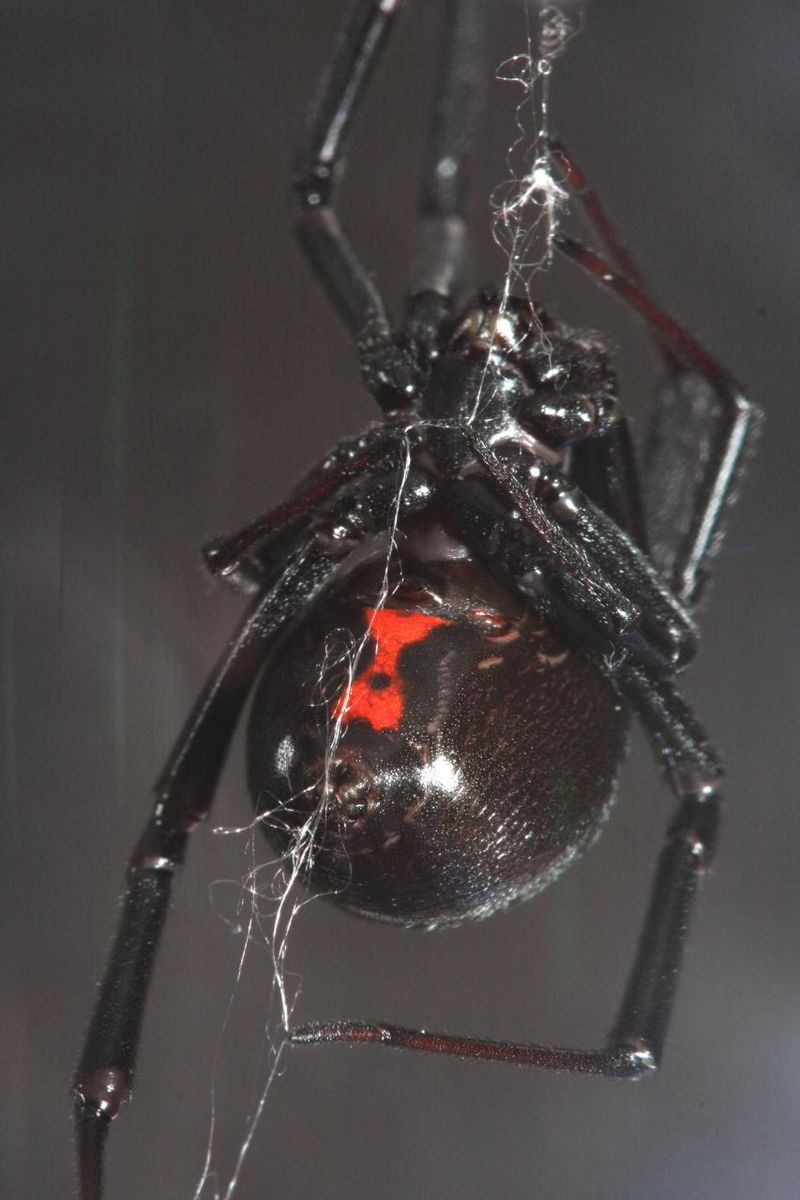
Scientific name: Latrodectus hesperus
Common name: western black widow, western widow.
This venomous spider can grow to 16mm in females.
They are black with a red hourglass shape on the lower end of the abdomen. The hourglass can also be yellow or white.
Males are half the length and tan in color.
Females carry potent venom, which is considered medically significant and if bitten you should seek immediate medical treatment. Symptoms associated with a black widow bite include pain, sweating, and nausea.
Futher Reading:
33. Wolf Spider

The Tigrosa annexa is a wolf spider native to eastern North America.
They have stripes on the dorsal body and legs, giving it a fierce look, though they are tolerant of being observed and are not aggressive towards humans, often will run to escape and only bite if they have no other choice.
Bites are painful, causing localized redness, inflammation, and pain, they are not medically significant and you shouldn’t need any medical attention.
34. Sylvan Jumping Spider

Scientific name: Colonus sylvanus
Common name: Sylvan Jumping Spider.
There is no much known about the small Sylvan jumping spider, except it belongs to the Salticidae family and can be found throughout the United States, including Texas.
This small spider does not spin webs to capture its prey but uses its incredible jumping ability to ambush and capture the prey using a single silk strand, which eliminates the risk of their prey escaping.
They are harmless to humans and very rarely bite unless they are threatened.
35. Arabesque Orbweaver

Scientific name: Neoscona arabesca
Common name: Arabesque Orbweaver.
The arabesque orbweaver varies in color from brown to orange and gray to black.
Females have a rounder abdomen with males being slender.
They both have short dashes and lines on the center of the abdomen and thick black dashes on both sides.
Females sit upside down in their orb-shaped webs at night waiting for prey to get entangled. Males hide nearby.
They are not aggressive and will usually run away if approached or their web is accidentally disturbed.
36. Brown Widow

Scientific name: Latrodectus geometricus
Common name: brown widow, brown button spider, grey widow, brown black widow, house button spider, geometric button spider.
Brown widows are lighter in color and smaller in size than black widows.
Their color ranges from tan and dark brown to black with shades of gray. They also have an hourglass on their belly, which is yellow or orange. It also has a black and white pattern on the dorsal side of the abdomen with stripes on the legs.
The brown widow bite is not very dangerous and does not require immediate medical treatment. The effects usually include the bite area and surrounding tissues.
Brown widow bites are not as dangerous as the black widow, as they are unable to deliver the same high amount of venom that the black widows are able to deliver.
37. Brown Recluse

Scientific name: Loxosceles reclusa
Common name: brown recluse, fiddleback spider, brown fiddler, violin spider.
Brown recluse spiders are also known as violin spiders and are gray to brown in color with lighter color on the legs and yellow to orange on the cephalothorax.
The head and eyes have a violin-shaped mark. They have six eyes in tight pairs. The first pair is in the front and center of the face, with the other two pairs on the sides.
They usually live in debris outside, but they are known to climb into shoes and piles of clothing, which is when most bites occur.
They are not aggressive but bite when they feel threatened, such as when you put your shoe on and they are inside. They have a toxic venom which causes rotting in human tissue around the bite area.
Infection sets in, which can spread to other organs. Wounds usually become crusty in appearance with redness and irritation. It can take months to heal.
If you think you have been bitten by a brown recluse, seek medical treatment immediately.
38. Long-bodied Cellar Spider

Scientific name: Pholcus phalangioides
Common name: daddy long-legs spider, long-bodied cellar spider, skull spider.
Long-bodied cellar spiders have elongated abdomens and a rounded bottom that tapers at the waist. They have long legs, which is why many people call them daddy long legs.
They tend to bounce in their webs to make themselves blurry to whoever is watching them.
They are venomous, but not poisonous to humans and their mouth is so small, that they are not known to bite humans. Their fangs are too small to be able to inject any venom.
39. Magnolia Green Jumping Spider
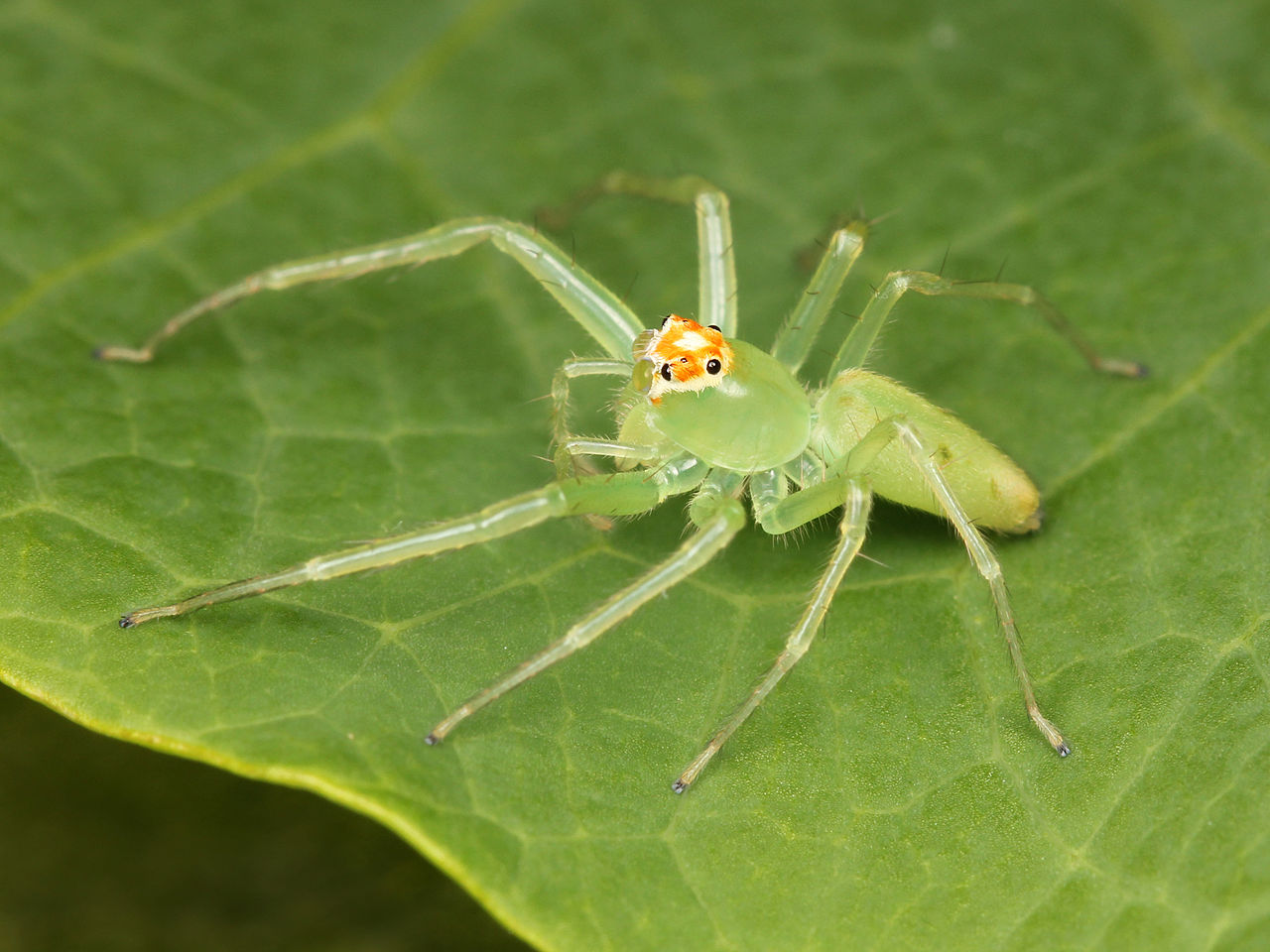
Scientific name: Lyssomanes viridis
Common name: magnolia green jumping spider.
The magnolia green jumping spider is a small spider with long and slender legs, unlike other jumping spiders, but it is still able to jump exceptional distances.
They ambush their prey with females being larger than the males.
Both males and females are gray with black dots on the abdomen.
They are mostly found in magnolia trees, but they also move into pine, maple, and oak trees. They are usually seen in the more humid and warmer parts of the United States.
40. Southwestern Trapdoor Spider

Scientific name: Eucteniza relata
Common name: southwestern trapdoor spider.
The southwestern trapdoor spider is from the Euctenizidae family and is medium-sized that is known to construct burrows with a trapdoor made of vegetation, soil, or silk.
These are large, harmless, and hairy spiders that live under the ground.
They can be very aggressive if disturbed or threatened, but their bites are not toxic to humans.
They can grow to around 2.5cm in length with eight eyes and colors ranging from black to red/brown to brown.
Their bodies are covered in hair.
They are exceptionally fast and will try and escape before it resorts to biting.
41. White-banded Fishing Spider

Scientific name: Dolomedes albineus
Common name: white-banded fishing spider.
White banded fishing spiders are species of nursery web spider that hunts in or close to ponds and streams.
Their hairs are able to repel the water, which gives the spider the ability to walk on water.
It is also able to trap an air bubble under the belly, which enables it to swim and dive, hunting aquatic inverts and tadpoles.
42. Furrow Orbweaver

Scientific name: Larinioides cornutus
Common name: furrow spider, furrow orb spider, foliate spider.
The furrow orbweaver has a large oval-shaped abdomen with females growing to 14mm and males to 9mm in length. Their leg span can be up to 35mm.
They can range in color from red to gray or black with a lighter shaded arrow pointing towards the cephalothorax on their abdomen and carapace. Their legs also have an arrow pattern.
They have six eyes in a horizontal row with an additional pair just above the central row.
The same as other orb-weavers, they are not dangerous to humans and would rather return to their web than defend themselves.
43. American Green Crab Spider

Scientific name: Misumessus oblongus
Common name: American Green Crab Spider.
The American green crab spider has the ability to work forwards, backward, and sideways.
They have long front legs that help them catch prey as they collect pollen.
They are usually a bright neon green color.
They are very small and can easily hide in petals of flowers.
They have a slender kite-shaped abdomen with red bands on the side, which may or may not be visible.
These crab spiders do not spin webs to catch prey but tend to climb plants searching for insects.
They are often found in fields, grass, and in shrubs.
Males are known to spin their webs to cover potential mates, which are double their size.
44. Carolina Jumping Spider

Scientific name: Phidippus carolinensis
Common name: Carolina Jumping Spider.
The Carolina jumping spider is a member of the Salticidae family and is a large jumping spider with gravid females growing to 22mm and males growing to only 3.3mm.
Females are usually black with orange on the top of the cephalothorax and abdomen with a black stripe on the abdomen.
Males are similar but tend to be a solid color with more red and orange.
Juveniles look the same as females.
45. Hogna antelucana
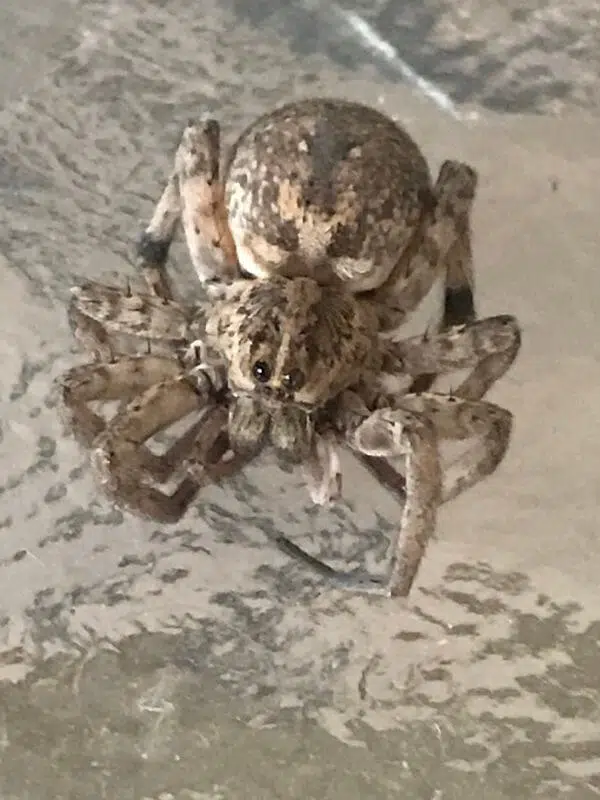
The Hogna antelucana is a species of wolf spider found in Texas that is harmless to humans unless threatened.
They will bite if you pose a threat or try and capture them. Their bites are not medically significant and not very common.
Not much is known about this timid spider that tends to keep to itself and is not often observed.
46. Southern House Spider
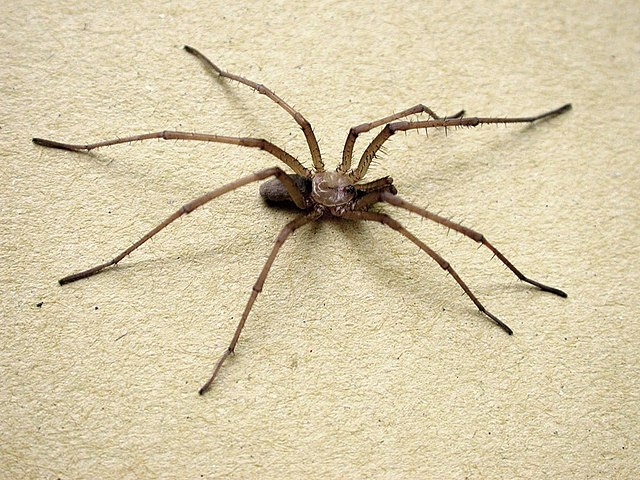
Scientific name: Kukulcania hibernalis (formerly Filistata hibernalis)
Common name: southern house spider.
It is not uncommon for homeowners to think that the southern house spider is a brown recluse. They have a similar body shape and color. The difference is that the southern house spider will not have a violin-shaped marking on its head.
Males are fast and large, they search for mates and prey, frightening people with their speed and size.
They are quite happy to crawl over you if you are in their path.
Their spindly legs make the male look different from the female.
Females tend to stay in their webs, hiding in floors and walls.
They are great in the home, keeping pests under control including flies, wasps, cockroaches, and beetles.
They are not venomous, but they can give a painful bite if they are cornered and feel threatened.
47. Cardinal Jumping Spider
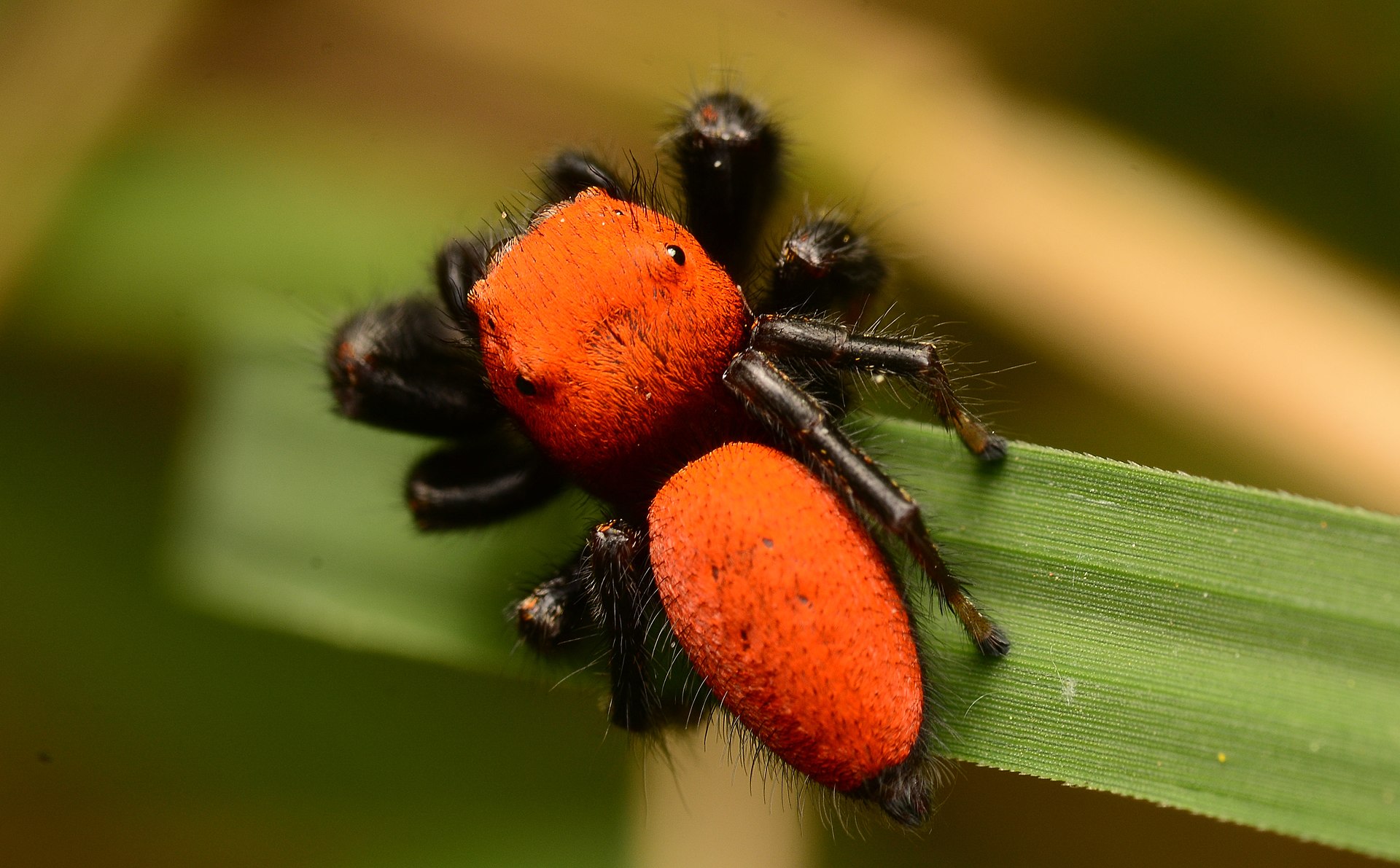
Scientific name: Phidippus cardinalis
Common name: cardinal jumper.
Cardinal jumping spiders, usually called the cardinal jumper that can give a very painful bite, but it is not venomous to humans.
These small spiders are active hunters using their excellent jumping skills to ambush prey and escape predators.
They make their way into the home in search of prey.
48. Lined Orbweaver

Scientific name: Mangora gibberosa
Common name: Lined Orbweaver.
The lined orbweaver can range from white to green and light brown with thin legs with long hairs. They have black lines on the underside of the two front pairs of legs.
They have a large and rounded abdomen with white, green, or yellow markings on the side. They also have two black to brown lines on the back of the abdomen and a central line on the carapace.
Males can grow up to 6mm with females being thirty percent larger than the male.
They spin orb-shaped webs that are large in diameter and the spider will sit in the center upside down waiting for its next meal to get entangled.
49. Dark Fishing Spider

Scientific name: Dolomedes tenebrosus
Common name: dark fishing spider.
Dark fishing spiders are often found in wooded areas where they live on trees.
Females can grow to 26mm, with males growing to 13mm.
Their legs can range up to 90mm.
They are dark brown to pale brown in color with chevron-like markings and light stripes on the legs. Legs are banded with black and brown.
50. Phidippus arizonensis

Phidippus arizonensis is a type of jumping spider that can be found in the United States and Mexico.
These spiders don’t spin their webs to capture prey, but rather ambush their prey by jumping at them while shooting out a single silk, which ensures the prey cannot escape.
They are not harmful to humans and will seldom bite unless provoked.
51. Falconina gracilis
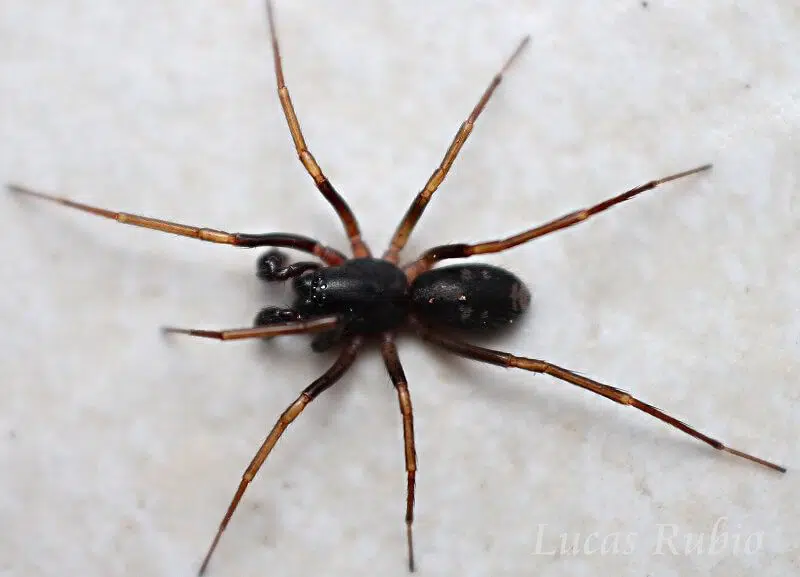
The Falconinia gracilis is a true spider in the Corinnidae family.
Originally from southern America, it has since been introduced to North America.
Little is known about these shy spiders that tend to remain hidden and are seldom observed.
52. Eastern Parson Spider

Scientific name: Herpyllus ecclesiasticus
Common name: Eastern parson spider.
The Eastern Parson spider has a white stripe on its abdomen which resembles a ruffled necktie that was worn in the eighteenth century.
They are fast, medium-sized hairy spiders that will roam walls and the ground during the night searching for prey. They are ambush predators.
They hide under boards, debris and rocks during the day.
They are known to venture indoors searching for food, though their natural habitat is woodlands.
They do not have a lethal bite, but their venom is known to cause allergic reactions in some people. Should you be bitten and experience any swelling in your face or throat, please seek urgent medical attention.
53. Messua limbata

The Messua limbata is a jumping spider that belongs to the Salticidae family found in the southern United States.
These small spiders using their ability to jump four times their body length to ambush prey and escape predators.
They are sometimes seen in homes searching for insects.
They are harmless and rarely bite. If they do bite if is because they were threatened, maybe you put on a piece of clothing and didn’t realize they were inside.
54. Ribbon Jumping Spider

Scientific name: Metacyrba taeniola
Common name: Ribbon Jumping Spider.
Ribbon jumping spiders belong to the Salticidae family with males being smaller than females.
Females can grow up to 0.28 inches (7.2mm) and males to around 0.24 inches (6mm).
They are excellent jumpers and use this to hunt and ambush prey, rather than spinning a web to capture their prey.
They do spin webs where they can retreat and store their prey for later.
55. Northern Crab Spider

Scientific name: Mecaphesa asperata
Common name: northern crab spider.
The Northern crab spider belongs to the Thomisidae family and is a flower spider species.
They tend to hunt in flowers that are a similar color to them, where they prey on bees and flies that are attracted to the pollen.
Their carapace, abdomen, and legs have short stiff spines with a white ocular region and red streaks on their abdomens.
The back of the abdomen is brown to red with a V shape towards the back.
They have yellow legs.
They are not considered medically significant and their bite is considered to be no worse than a bee sting.
56. Colonus puerperus

The Colonus puerperus jumping spider has physical characteristics that are different from the other jumping spiders.
Males tend to look different from females.
The posteromedian tract of the male looks like white scales with red to orange areas around the carapace.
Females have lateral bands on their dorsal abdomen and have yellow on their legs, which make them stand out on white backgrounds.
As with the other jumping spiders, they are harmless to humans.
57. Filmy Dome Spider

Scientific name: Neriene radiata
Common name: filmy dome spider.
This is a sheetweb spider known for creating a unique web. They create dome-like sheets.
They remain hidden in leaf litter during the day, coming out at night to feed.
They tend to be black or brown with white or yellow stripes on the abdomen, though some are black and white.
Males are smaller than the female with an elongated abdomen. Females have bulb-shaped abdomen.
They are usually found in wooded areas close to the ground.
58. White-banded Crab Spider

Scientific name: Misumenoides formosipes
Common name: white banded crab spider.
The white-banded crab spider has a white line that runs through the eyes.
They are sit-and-wait predators that capture insects that come to flowers to collect pollen.
They have exceptionally strong front legs they use to capture their prey.
Females are larger than males with various markings and a body color that can change between yellow and white.
Males have darker legs and a golden abdomen.
59. Phidippus texanus

The Phidippus texanus is a jumping spider that belongs to the Salticidae family found in the United States where it uses its ability to jump great distances to ambush prey and escape predators.
They don’t usually bite unless you pick them up and accidentally squeeze them. They are often curious and will happily crawl and jump over your fingers.
60. Goldenrod Crab Spider

Scientific name: Misumena vatia
Common name: goldenrod crab spider, flower (crab) spider.
The goldenrod crab spider uses camouflage as its defense. They are able to change color over a few days, helping them blend in with their surroundings. They can be anything from bright yellow to light green.
They are ambush spiders and do not spin webs, they sit in the center of a flower and wait for a pollen collector to land.
Males are smaller in size with dark black front legs and light green back legs, their abdomen is cream with two red lines in the center. Females are often plain white or yellow with pale legs.
Further Reading: